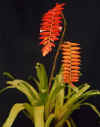The genus Tillandsia was established in 1753 by
Linnaeus and named for the Swedish botanist Elias Tillands (1640-1693).
The
tillandsias were at first thought to be, and classified as, relatives of mistletoe.
The genus belongs to the subfamily Tillandsioidiae and comprises over 500 species in six
subdivisions. This is the largest bromeliad family and the one with the widest range of
size and form variation as well as the widest geographical distribution.
This plant
family also shows the widest range of plant adaptation: from terrestrials, growing
in soil, to atmospherics, which do not use roots for water and nutrient uptake.
HABITAT:
Tillandsias are found from the southern United States through Central America and
South America to Argentina, some growing terrestrially, most however as epiphytes on trees
and cactus, or on rock and loose sand. Some grow in a humid rain forest environment
(mesic), others grow in an arid, sunny desert environment (xeric).
CULTURE:
Green-leafed tillandsias appreciate good light; gray- (silver-,
white-) leafed tillandsias must have much brighter light (sun, with due caution).
A
potted green-leafed tillandsia should be watered at the center (many have
"tanks"). The gray-leafed Tillandsia should be misted daily and/or
submerged in water a few hours or so weekly. Gray-leafed tillandsia leaf surfaces must
dry thoroughly between waterings. Although they grow in nutrient-poor situations,
tillandsias benefit from fertilizing. The fertilizer should be given at no more than
˝ strength and should contain ammoniacal nitrogen, which can be absorbed through the
leaves. Fertilizing is not necessary but will produce larger leaves, earlier
maturity, more abundant flowers.
CHARACTERISTICS:
Form: rosette, but, especially in the atmospherics, the basic rosette form may not
be recognizable. The atmospherics do not impound water and grow naturally so that
water drains out after a rain.
Size:
from ˝" (the moss-like tillandsias bryoides, tricholepis) to
7-10'or more (secunda, utriculata)
Leaves: few (most atmospherics) to many; smooth edged, sharply pointed, thin, soft
and flexible to stiff, brittle, succulent. Smooth and green to fuzzy and white, depending
on the density and character of the trichomes.
Leaves surrounding inflorescence may turn bright red or orange as blooming time
approaches. In some tillandsias (T. capitata, T. brachycaulos) the entire plant turns
intense red. The color usually fades soon after flowering.
Inflorescence:
Short-or no-stemmed (Spanish moss, T.
ionantha) but mostly long-stemmed, upright or
pendant, simple or branched. Scape bracts may be intensely colored: hot pink (T.
cyanea),
red, red with yellow tips.
Flowers emerge from bracts singly, or a few at a time over an extended period.
Flowers:
Flaring or
long and tubular; last three to four days; may be fragrant. Intense color: yellow,
white, purple, red, often contrasts strikingly with the color of the scape or the
surrounding leaves.
Fruits:
Seeds are borne in capsules which split open; seeds are air-borne by a tuft
of hairs (cf. dandelion) which also enable the seed to hold fast to
the substrate it lands on.
|
|

